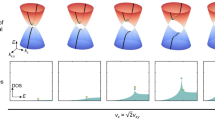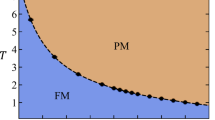Abstract
Competition between electronic ground states near a quantum critical point1,2 (QCP)—the location of a zero-temperature phase transition driven solely by quantum-mechanical fluctuations—is expected to lead to unconventional behaviour in low-dimensional systems3. New electronic phases of matter have been predicted to occur in the vicinity of a QCP by two-dimensional theories3,4,5,6,7,8, and explanations based on these ideas have been proposed for significant unsolved problems in condensed-matter physics, such as non-Fermi-liquid behaviour and high-temperature superconductivity. But the real materials to which these ideas have been applied are usually rendered three-dimensional by a finite electronic coupling between their component layers; a two-dimensional QCP has not been experimentally observed in any bulk three-dimensional system, and mechanisms for dimensional reduction have remained the subject of theoretical conjecture9,10,11. Here we show evidence that the Bose–Einstein condensate of spin triplets in the three-dimensional Mott insulator BaCuSi2O6 (refs 12–16) provides an experimentally verifiable example of dimensional reduction at a QCP. The interplay of correlations on a geometrically frustrated lattice causes the individual two-dimensional layers of spin-½ Cu2+ pairs (spin dimers) to become decoupled at the QCP, giving rise to a two-dimensional QCP characterized by linear power law scaling distinctly different from that of its three-dimensional counterpart. Thus the very notion of dimensionality can be said to acquire an ‘emergent’ nature: although the individual particles move on a three-dimensional lattice, their collective behaviour occurs in lower-dimensional space.
This is a preview of subscription content, access via your institution
Access options
Subscribe to this journal
Receive 51 print issues and online access
$199.00 per year
only $3.90 per issue
Buy this article
- Purchase on Springer Link
- Instant access to full article PDF
Prices may be subject to local taxes which are calculated during checkout




Similar content being viewed by others
References
Sachdev, S. Quantum Phase Transitions (Cambridge Univ. Press, New York, 1999)
Hertz, J. Quantum critical phenomena. Phys. Rev. B 14, 1165–1184 (1976)
Sachdev, S. Quantum criticality: Competing ground states in low dimensions. Science 288, 475–480 (2000)
Stockert, O., von Lohneysen, H., Rosch, A., Pyka, N. & Loewenhaupt, M. Two-dimensional fluctuations at the quantum-critical point of CeCu6-xAux . Phys. Rev. Lett. 80, 5627–5630 (1998)
Si, Q., Rabello, S., Ingersent, K. & Smith, J. L. Locally critical quantum phase transitions in strongly correlated metals. Nature 413, 804–808 (2001)
Mathur, N. D. et al. Magnetically mediated superconductivity in heavy fermion compounds. Nature 394, 39–43 (1998)
Senthil, T., Vishwanth, A., Balents, L., Sachdev, S. & Fisher, M. P. A. Deconfined quantum critical points. Science 303, 1490–1494 (2004)
Millis, A. J. Effect of a nonzero temperature on quantum critical points in itinerant fermion systems. Phys. Rev. B 48, 7183–7196 (1993)
Xu, C. & Moore, J. E. Geometric criticality for transitions between plaquette phases in integer-spin Kagome XXZ antiferromagnets. Phys. Rev. B 72, 064455 (2005)
Batista, C. D. & Nussinov, Z. Generalized Elitzur's theorem and dimensional reductions. Phys. Rev. B 72, 045137 (2005)
Tewari, S., Toner, J. & Chakravarty, S. Floating phase in a dissipative Josephson junction array. Phys. Rev. B 72, 060505(R) (2005)
Jaime, M. et al. Magnetic-field-induced condensation of triplons in Han purple pigment BaCuSi2O6 . Phys. Rev. Lett. 93, 087203 (2004)
Sebastian, S. E. et al. Characteristic Bose-Einstein condensation scaling close to a quantum critical point in BaCuSi2O6 . Phys. Rev. B 72, 100404(R) (2005)
FitzHugh, E. W. & Zycherman, L. A. A purple barium copper silicate pigment from early China. Studies Conserv. 37, 145–154 (1992)
Nikuni, T., Oshikawa, M., Oosawa, A. & Tanaka, H. Bose-Einstein condensation of diluted magnons in TlCuCl3 . Phys. Rev. Lett. 84, 5868–5871 (2000)
Ruegg, Ch. et al. Bose-Einstein condensation of the triplet states in the magnetic insulator TlCuCl3 . Nature 423, 62–65 (2003)
Sparta, K. M. & Roth, G. Reinvestigation of the structure of BaCuSi2O6–evidence for a phase transition at high temperature. Acta Crystallogr. B 60, 491–495 (2004)
Samulon, E. C. et al. Low temperature structural phase transition and incommensurate lattice modulation in the spin gap compound BaCuSi2O6 . Phys. Rev. B 73, 100407(R) (2006)
Sasago, Y., Uchinokura, K., Zheludev, A. & Shirane, A. Temperature-dependent spin gap and singlet ground state in BaCuSi2O6 . Phys. Rev. B 55, 8357–8360 (1991)
Mila, F. Ladders in a magnetic field: a strong coupling approach. Eur. Phys. J. B 6, 201–205 (1998)
Giamarchi, T. & Tsvelik, A. M. Coupled ladders in a magnetic field. Phys. Rev. B 59, 11398–11407 (1999)
Rice, T. M. To condense or not to condense. Science 298, 760–761 (2002)
Kawashima, N. Quantum critical point of the XY model and condensation of field-induced quasiparticles in dimer compounds. J. Phys. Soc. Jpn 73, 3219–3222 (2004)
Fisher, M. P. A. et al. Boson localization and the superfluid-insulator transition. Phys. Rev. B 40, 546–570 (1989)
Nohadani, O. et al. Universal scaling at field-induced magnetic phase transitions. Phys. Rev. B 69, 220402(R) (2004)
Harris, A. B. Effect of random defects on the critical behaviour of Ising models. J. Phy. C 7, 1671–1692 (1974)
Vojta, T. & Sknepnek, R. Critical points and quenched disorder: from Harris criterion to rare regions and smearing. Phys. Status Solidi B 241, 2118–2127 (2004)
Maltseva, M. & Coleman, P. Failure of geometric frustration to preserve a quasi-two-dimensional spin fluid. Phys. Rev. B 72, 174415(R) (2005)
Henley, C. L. Ordering due to disorder in a frustrated vector antiferromagnet. Phys. Rev. Lett. 62, 2056–2059 (1989)
Acknowledgements
N.H., C.D.B., M.J. and P.A.S. acknowledge Laboratory Directed Research and Development (LDRD) support at LANL. S.E.S and I.R.F. acknowledge National Science Foundation (NSF) support. Experiments performed at the NHMFL, Tallahassee, were supported by the NSF, the State of Florida, and the Department of Energy. We thank T. P. Murphy, E. C. Palm, P. Tanedo and P. B. Brooks for experimental assistance, and acknowledge discussions with A. G. Green, E.-A. Kim, S. A. Kivelson, D. I. Santiago and J. Schmalian. I.R.F. acknowledges support from the Alfred P. Sloan Foundation and S.E.S. from the Mustard Seed Foundation.
Author information
Authors and Affiliations
Corresponding author
Ethics declarations
Competing interests
Reprints and permissions information is available at npg.nature.com/reprintsandpermissions. The authors declare no competing financial interests.
Rights and permissions
About this article
Cite this article
Sebastian, S., Harrison, N., Batista, C. et al. Dimensional reduction at a quantum critical point. Nature 441, 617–620 (2006). https://doi.org/10.1038/nature04732
Received:
Accepted:
Issue Date:
DOI: https://doi.org/10.1038/nature04732
This article is cited by
-
Characterizing ancient materials
Nature Materials (2023)
-
Egyptian blue, Chinese blue, and related two-dimensional silicates: from antiquity to future technologies. Part A: general properties and historical uses
Rendiconti Lincei. Scienze Fisiche e Naturali (2023)
-
Dimensional reduction by geometrical frustration in a cubic antiferromagnet composed of tetrahedral clusters
Nature Communications (2021)
-
Triplon band splitting and topologically protected edge states in the dimerized antiferromagnet
Nature Communications (2019)
-
Quantum criticality among entangled spin chains
Nature Physics (2018)
Comments
By submitting a comment you agree to abide by our Terms and Community Guidelines. If you find something abusive or that does not comply with our terms or guidelines please flag it as inappropriate.



